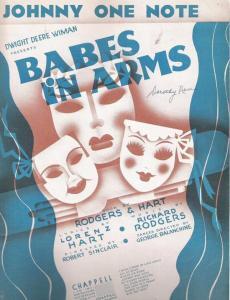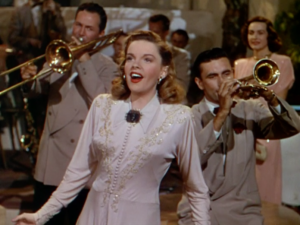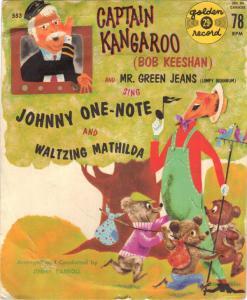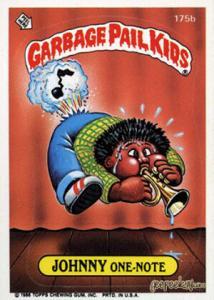 Set forth below is the sixty-first “Texas Shout” column. It first appeared in the May 1995 issue of the West Coast Rag). The text has not been updated.
Set forth below is the sixty-first “Texas Shout” column. It first appeared in the May 1995 issue of the West Coast Rag). The text has not been updated.
Remember the 1937 Rodgers & Hart song “Johnny One Note?” From the show Babes In Arms, it told of a singer who, as his name implies, could only sing one note. However, he sang it so magnificently that all who heard him were mesmerized – even traffic stopped and Niagara Falls stood still.
 If Johnny One Note really existed, I think a lot of us would be curious to hear a recording of what he sounded like. I suspect, though, that we would be perfectly satisfied to have a 78 rpm recording of Johnny. It would contain only two renditions, each subject to a time limit of about three minutes.
If Johnny One Note really existed, I think a lot of us would be curious to hear a recording of what he sounded like. I suspect, though, that we would be perfectly satisfied to have a 78 rpm recording of Johnny. It would contain only two renditions, each subject to a time limit of about three minutes.
If Johnny had come along during the LP years, his album would run some 45 minutes. By that time, his act, good as it was, would probably start getting a little old for most people.
How about a full 70-minute CD of Johnny? I rather think that the average listener would be unable to make it through to the end without his/her mind wandering for the last half-hour of the journey.
There have always been a lot of Johnny One Note (henceforth J1N) artists on the scene. These are individuals, combos, etc., who have learned to do one thing superbly well.
Before records came along, you didn’t need to be more than a J1N. You were doing a fifteen-minute turn at a vaudeville house, moving on after a few days to a new location, and not returning for some time. When you did come back, the audience, recalling your previous triumph, was usually perfectly satisfied to see you do the same thing with which you entertained them for fifteen minutes last year.
78 rpm records worked much the same way. Even a very popular artist would have new platters released no more frequently than every few months. The buyers thereof wanted the performer to touch base by doing his/her specialty with only slight variations.
Making a 78 was much like making sequels in the movies today. Now we go to see “Rocky Part XXXVI” because we want to see the stars doing much the same thing we liked so much the first time. We want only a tiny difference, just enough to keep deja vu from overtaking us.
By contrast, the era of long-playing records and CDs is a difficult one for J1Ns. Instead of having to plan just an individual performance or two, the musician needs to produce something that unfolds in a way that will keep his/her audience engrossed for a duration of over an hour.

The overall product, as well as each individual ride, needs to be assembled so that it will hold the listener’s attention. How should the program proceed in terms of faster vs. slower numbers, instrumentals vs. vocals, full-band sides vs. subunits or features, and whatever other options are available? Do it the wrong way and, even if each cut works on its own, you run the risk of having your purchaser reach the end of your album in a disinterested, negative frame of mind.
I see this effect fairly often when I encounter chronological compilations of recordings by an artist from the vintage years – not the great ones, like Louis, Bessie, Bix, Fats, Jelly, et al. They transcended the restrictions of 78 marketing so that we can hear them on CD without becoming distracted for an instant.
This result does not occur, though, for the majority of performers, those highly competent jazzmen who nevertheless did not possess the genius of the above-named immortals. Take for example, the legions of very fine boogie-blues pianists or blues singers who tended to record 12-bar three-chord pieces, often with little or no variation in tempo or key. While I enjoy hearing their reissues, in many cases the track-to-track differences are so minor that, by the time the album ends, I have trouble remembering just which title was which (maybe my difficulty merely reflects the initial stages of senility, but I doubt it).
I can live with this situation as far as reissues are concerned. I make a sort of automatic allowance for that fact that the artist was doing the right thing for the technology of the time. It isn’t fair to criticize these J1Ns for failing to (1) anticipate a 70-minute CD and (2) produce a body of material that would flow in exactly the right way when compiled into one.
I have more trouble making such an allowance for today’s performers. Yet, what is a J1N of the 1990s to do?
Most artists of interest to American Rag readers sell the bulk of recordings at their in-person performances. This situation forecloses the option of sharing a CD with another musician whose talents might provide the balance that would make the disc more enjoyable overall and would set our J1N’s unique abilities into sharper focus.
That’s because much of the audience for a live performer really doesn’t want to pony up a CD price for a recording that devotes only half (or less) of its running time to the player they’ve just seen. The excitement of attending an in-person concert tends to mask the J1N aspects of the show, aspects that don’t really emerge clearly until the disc is playing in the living room without the cheering crowd, the you-are-there thrill.
How should a reviewer deal with a new J1N album? If each separate rendition clicks standing alone, should he/she give it an above-average rating and tell all of you to spend your money on it? Or should he/she acknowledge being bored beyond description at hearing the same thing over and over for some 15-20 selections and admit that the recording is probably going to spend the rest of its life on the shelf?
I thought of writing about this topic when a couple of CDs arrived at my home that more or less fit the J1N category. I had planned to close these remarks by giving you a couple of real-life examples.
I’ve changed my mind. The records really are pretty good if you approach them the right way, usually by not trying to listen intently all the way through at one sitting. Besides, I don’t see any purpose in saddling someone with the doubtful honor of being a J1N.
 Jazz literature is filled with comments about the “limitations” of 78 rpm records, meaning the necessity to complete the performance within about three minutes. Yet, many immortal jazz renditions were created within those “limitations.” It’s hard to visualize how they could have been improved, no matter how much additional time was available.
Jazz literature is filled with comments about the “limitations” of 78 rpm records, meaning the necessity to complete the performance within about three minutes. Yet, many immortal jazz renditions were created within those “limitations.” It’s hard to visualize how they could have been improved, no matter how much additional time was available.
By contrast, for practical purposes, we can now play as long as we want to when making records. Still, most Dixieland and ragtime rides on CDs nevertheless wind up being not much more than three minutes anyway, usually coming in somewhere around four.
Perhaps there is something about the idiom that dictates economy most of the time, vs. more modern forms of jazz which take much longer to complete a ride. Or, maybe because the vintage recordings that attracted them to Dixieland are on the shortish side, today’s musicians might be conditioned to complete their statements somewhere close to the old durations. Whatever the reason, you never see 10-chorus Dixieland solos, but they’re all over the place in modern jazz.
At any rate, now that we are free of the limitations of 78s, we have a new set of problems, those dealing with planning a 70-minute program that stays afloat every step of the way. Seems a bit ironic, doesn’t it?
I suppose, though, that we live in a time when, it has been said, “The medium is the message.” Perhaps that thought is the only one we need to sum up today’s musings.
Sooner or later you’ll find yourself with an album that, for reasons you can’t quite identify, doesn’t satisfy you the way it should. All the performances are up to standard, maybe even better. Yet, you reach the end of the playing time lost in daydreams, possibly feeling a little exhausted.
In that case, perhaps the artist really isn’t to blame. The fault may lie entirely with the format in which today’s market requires the artist to appear. Anyone for bringing back vaudeville?
The following note was added to this column when it was reprinted in The American Rag in June of 2003:
We are getting into the home stretch of these “Texas Shout” reprints. There are just fourteen left to go. As I wound the series down, I wrote a number of columns designed to getting my readers thinking about ways to improve the scene.
When The American Rag began the reprints, I expressed some reservations about their continued relevance in light of the rapidly deteriorating audience for Dixieland jazz and ragtime. Don felt strongly that we should re-run them, so I have acquiesced and, where appropriate, added a few post-scripts.
Thus, we might as well run out the string to the end even when a column comes along, like this one, that seems to me to be pointless in view of what is now happening with regard to recordings of our music. For example, just before preparing this column for reprinting, I read that a major chain of stores devoted to stocking a broad base of recordings of all types has filed for bankruptcy, being unable to compete with emporia offering many kinds of products (like Best Buy and Wal-Mart) that use top-selling CDs as loss leaders to get folks inside their doors.

Of course, these latter giant markets do not pretend to have comprehensive CD sections. They offer only the few hot fast-moving current pops, almost always by the day’s teen-age heartthrobs. Nobody who is an avid collector of Dixieland or ragtime recordings (or classical, or ethnic, or gospel, or many other currently marginal musical styles) is going to bother checking Best Buy or Wal-Mart.
What this development tells me is that the commercial market for recordings, like that for Hollywood movies, has now been completely taken over by products aimed at adolescents and pre-adolescents. Other musics don’t pay their way in terms of store space. If you don’t believe me, go into the jazz section of a large well-stocked record store (if you can find one) and count the number of people browsing though the jazz CDs.
Further, CDs have become so cheap and easy to manufacture that some recordings now are made by artists in local non-studio sites, such as churches or private homes; recorded on tiny, easily-portable digital recorders; edited on home computers; and burned off one at a time in living rooms as orders come in. Moreover, they often sound great – indistinguishable from studio sessions in some cases I’ve seen.
Most recordings of our music are now produced by the artists themselves and sold at their live gigs. The aging audience thereof doesn’t buy much by mail these days, possibly because older folks already have a full shelf of LPs, tapes and CDs accumulated over the decades and are looking to downsize their possessions.
To illustrate, my guess is that a favorable review in The American Rag of a new Dixieland recording will most likely attract no mail orders, rarely more than two. Current record reviews serve no purpose beyond getting the writer’s and artist’s names in print, no longer justifying the time and effort involved in doing a quality job of writing them.
In these circumstances, nothing anyone says about Dixieland and ragtime recordings makes the slightest difference anymore. Included in that category are the comments in today’s reprinted column and some of the ones coming up.
 Want to read ahead? Buy the book!
Want to read ahead? Buy the book!
The full run of “Texas Shout” has been collected into a lavishly illustrated trade paperback entitled Texas Shout: How Dixieland Jazz Works. This book is available @ $20.00 plus $2.95 shipping from Tex Wyndham, On request, Tex will autograph the book and add a personalized note (be sure to tell him to whom the note should be addressed).
Tex Wyndham’s 3 CD Guide to Dixieland with music and commentary is available for $20 plus $2.95 shipping. The separate CD, A History of Ragtime: Tex Wyndham Live At Santa Rosa, is available for $13.00 plus $2.00 shipping. On request, Tex will autograph the inner sleeve and add a personalized note (be sure to tell him to whom the note should be addressed).
Send payment to Tex Wyndham, P.O. Box 831, Mendenhall, PA 19357, Phone (610) 388-6330.
Note: All links, pictures, videos or graphics accompanying the Shouts were added at the discretion of the Syncopated Times editorial staff. They did not accompany the original columns and do not necessarily reflect the opinion of Tex Wyndham.
From roughly 1970-2010, Tex Wyndham was: (1) one of the best-known revivalist Dixieland jazz musicians in the US, as cornetist, pianist and bandleader, (2) one of the best-known ragtime pianists in the US, and (3) one of the most respected critics in the US of Dixieland jazz, ragtime, and related music. He is the only person about whom all three of those statements can be made.


















